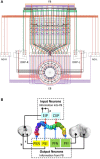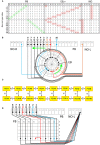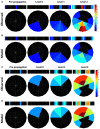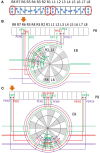The Topographical Mapping in Drosophila Central Complex Network and Its Signal Routing
- PMID: 28443014
- PMCID: PMC5385387
- DOI: 10.3389/fninf.2017.00026
The Topographical Mapping in Drosophila Central Complex Network and Its Signal Routing
Abstract
Neural networks regulate brain functions by routing signals. Therefore, investigating the detailed organization of a neural circuit at the cellular levels is a crucial step toward understanding the neural mechanisms of brain functions. To study how a complicated neural circuit is organized, we analyzed recently published data on the neural circuit of the Drosophila central complex, a brain structure associated with a variety of functions including sensory integration and coordination of locomotion. We discovered that, except for a small number of "atypical" neuron types, the network structure formed by the identified 194 neuron types can be described by only a few simple mathematical rules. Specifically, the topological mapping formed by these neurons can be reconstructed by applying a generation matrix on a small set of initial neurons. By analyzing how information flows propagate with or without the atypical neurons, we found that while the general pattern of signal propagation in the central complex follows the simple topological mapping formed by the "typical" neurons, some atypical neurons can substantially re-route the signal pathways, implying specific roles of these neurons in sensory signal integration. The present study provides insights into the organization principle and signal integration in the central complex.
Keywords: Drosophila; central complex; neural networks; protocerebral bridge; topographical mapping.
Figures






Similar articles
-
Polarity-specific high-level information propagation in neural networks.Front Neuroinform. 2014 Mar 17;8:27. doi: 10.3389/fninf.2014.00027. eCollection 2014. Front Neuroinform. 2014. PMID: 24672472 Free PMC article.
-
Neuroarchitecture and neuroanatomy of the Drosophila central complex: A GAL4-based dissection of protocerebral bridge neurons and circuits.J Comp Neurol. 2015 May 1;523(7):997-1037. doi: 10.1002/cne.23705. Epub 2014 Dec 16. J Comp Neurol. 2015. PMID: 25380328 Free PMC article.
-
Simulation of signal flow in 3D reconstructions of an anatomically realistic neural network in rat vibrissal cortex.Neural Netw. 2011 Nov;24(9):998-1011. doi: 10.1016/j.neunet.2011.06.013. Epub 2011 Jun 25. Neural Netw. 2011. PMID: 21775101
-
Building a heading signal from anatomically defined neuron types in the Drosophila central complex.Curr Opin Neurobiol. 2018 Oct;52:156-164. doi: 10.1016/j.conb.2018.06.010. Epub 2018 Jul 18. Curr Opin Neurobiol. 2018. PMID: 30029143 Free PMC article. Review.
-
Consequences of tuning network function by tonic and phasic locus coeruleus output and stress: Regulating detection and discrimination of peripheral stimuli.Brain Res. 2019 Apr 15;1709:16-27. doi: 10.1016/j.brainres.2018.06.015. Epub 2018 Jun 13. Brain Res. 2019. PMID: 29908165 Review.
Cited by
-
A Single-Cell Level and Connectome-Derived Computational Model of the Drosophila Brain.Front Neuroinform. 2019 Jan 10;12:99. doi: 10.3389/fninf.2018.00099. eCollection 2018. Front Neuroinform. 2019. PMID: 30687056 Free PMC article.
-
Building a functional connectome of the Drosophila central complex.Elife. 2018 Aug 20;7:e37017. doi: 10.7554/eLife.37017. Elife. 2018. PMID: 30124430 Free PMC article.
-
Global inhibition in head-direction neural circuits: a systematic comparison between connectome-based spiking neural circuit models.J Comp Physiol A Neuroethol Sens Neural Behav Physiol. 2023 Jul;209(4):721-735. doi: 10.1007/s00359-023-01615-z. Epub 2023 Feb 13. J Comp Physiol A Neuroethol Sens Neural Behav Physiol. 2023. PMID: 36781446 Free PMC article.
-
Coupled symmetric and asymmetric circuits underlying spatial orientation in fruit flies.Nat Commun. 2017 Jul 26;8(1):139. doi: 10.1038/s41467-017-00191-6. Nat Commun. 2017. PMID: 28747622 Free PMC article.
References
LinkOut - more resources
Full Text Sources
Other Literature Sources
Molecular Biology Databases

